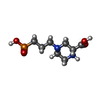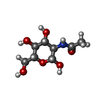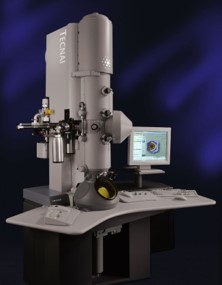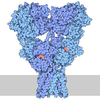[English] 日本語
 Yorodumi
Yorodumi- PDB-8xlk: Structure of native tri-heteromeric GluN1-GluN2A-GluN2B NMDA rece... -
+ Open data
Open data
- Basic information
Basic information
| Entry | Database: PDB / ID: 8xlk | |||||||||||||||||||||||||||||||||||||||||||||
|---|---|---|---|---|---|---|---|---|---|---|---|---|---|---|---|---|---|---|---|---|---|---|---|---|---|---|---|---|---|---|---|---|---|---|---|---|---|---|---|---|---|---|---|---|---|---|
| Title | Structure of native tri-heteromeric GluN1-GluN2A-GluN2B NMDA receptor in rat cortex and hippocampus | |||||||||||||||||||||||||||||||||||||||||||||
 Components Components |
| |||||||||||||||||||||||||||||||||||||||||||||
 Keywords Keywords | MEMBRANE PROTEIN/IMMUNE SYSTEM / MEMBRANE PROTEIN / native NMDA receptor / adult rat cartex & hippocampus / GluN2A / GluN2B / MEMBRANE PROTEIN-IMMUNE SYSTEM complex | |||||||||||||||||||||||||||||||||||||||||||||
| Function / homology |  Function and homology information Function and homology informationneurotransmitter receptor transport, plasma membrane to endosome / regulation of response to alcohol / cellular response to curcumin / response to ammonium ion / cellular response to corticosterone stimulus / cellular response to magnesium starvation / receptor recycling / sensory organ development / directional locomotion / response to environmental enrichment ...neurotransmitter receptor transport, plasma membrane to endosome / regulation of response to alcohol / cellular response to curcumin / response to ammonium ion / cellular response to corticosterone stimulus / cellular response to magnesium starvation / receptor recycling / sensory organ development / directional locomotion / response to environmental enrichment / pons maturation / positive regulation of Schwann cell migration / regulation of cell communication / sensitization / EPHB-mediated forward signaling / Assembly and cell surface presentation of NMDA receptors / response to hydrogen sulfide / auditory behavior / olfactory learning / conditioned taste aversion / dendritic branch / regulation of respiratory gaseous exchange / response to other organism / protein localization to postsynaptic membrane / regulation of ARF protein signal transduction / serotonin metabolic process / fear response / apical dendrite / cellular response to magnesium ion / transmitter-gated monoatomic ion channel activity / positive regulation of inhibitory postsynaptic potential / suckling behavior / response to methylmercury / response to manganese ion / response to glycine / propylene metabolic process / response to carbohydrate / sleep / interleukin-1 receptor binding / dendritic spine organization / locomotion / regulation of NMDA receptor activity / cellular response to dsRNA / response to growth hormone / cellular response to lipid / negative regulation of dendritic spine maintenance / heterocyclic compound binding / positive regulation of glutamate secretion / regulation of monoatomic cation transmembrane transport / RAF/MAP kinase cascade / NMDA glutamate receptor activity / Synaptic adhesion-like molecules / voltage-gated monoatomic cation channel activity / response to glycoside / NMDA selective glutamate receptor complex / glutamate binding / ligand-gated sodium channel activity / neurotransmitter receptor complex / response to morphine / regulation of axonogenesis / glutamate receptor signaling pathway / regulation of dendrite morphogenesis / neuromuscular process / calcium ion transmembrane import into cytosol / protein heterotetramerization / male mating behavior / regulation of synapse assembly / glycine binding / spinal cord development / response to amine / regulation of cAMP/PKA signal transduction / receptor clustering / small molecule binding / cellular response to zinc ion / startle response / monoatomic cation transmembrane transport / parallel fiber to Purkinje cell synapse / dopamine metabolic process / positive regulation of reactive oxygen species biosynthetic process / response to lithium ion / behavioral response to pain / regulation of MAPK cascade / positive regulation of calcium ion transport into cytosol / cellular response to glycine / modulation of excitatory postsynaptic potential / associative learning / response to light stimulus / regulation of postsynaptic membrane potential / action potential / extracellularly glutamate-gated ion channel activity / response to magnesium ion / conditioned place preference / excitatory synapse / response to electrical stimulus / monoatomic cation transport / positive regulation of dendritic spine maintenance / social behavior / regulation of neuronal synaptic plasticity / monoatomic ion channel complex / positive regulation of protein targeting to membrane Similarity search - Function | |||||||||||||||||||||||||||||||||||||||||||||
| Biological species |   | |||||||||||||||||||||||||||||||||||||||||||||
| Method | ELECTRON MICROSCOPY / single particle reconstruction / cryo EM / Resolution: 4.2 Å | |||||||||||||||||||||||||||||||||||||||||||||
 Authors Authors | Zhang, M. / Feng, J. / Li, Y. / Zhu, S. | |||||||||||||||||||||||||||||||||||||||||||||
| Funding support |  China, 1items China, 1items
| |||||||||||||||||||||||||||||||||||||||||||||
 Citation Citation |  Journal: Cell / Year: 2025 Journal: Cell / Year: 2025Title: Assembly and architecture of endogenous NMDA receptors in adult cerebral cortex and hippocampus. Authors: Ming Zhang / Juan Feng / Chun Xie / Nan Song / Chaozhi Jin / Jian Wang / Qun Zhao / Lihua Zhang / Boshuang Wang / Yidi Sun / Fei Guo / Yang Li / Shujia Zhu /  Abstract: The cerebral cortex and hippocampus are crucial brain regions for learning and memory, which depend on activity-induced synaptic plasticity involving N-methyl-ᴅ-aspartate receptors (NMDARs). ...The cerebral cortex and hippocampus are crucial brain regions for learning and memory, which depend on activity-induced synaptic plasticity involving N-methyl-ᴅ-aspartate receptors (NMDARs). However, subunit assembly and molecular architecture of endogenous NMDARs (eNMDARs) in the brain remain elusive. Using conformation- and subunit-dependent antibodies, we purified eNMDARs from adult rat cerebral cortex and hippocampus. Three major subtypes of GluN1-N2A-N2B, GluN1-N2B, and GluN1-N2A eNMDARs were resolved by cryoelectron microscopy (cryo-EM) at the resolution up to 4.2 Å. The particle ratio of these three subtypes was 9:7:4, indicating that about half of GluN2A and GluN2B subunits are incorporated into the tri-heterotetramers. Structural analysis revealed the asymmetric architecture of the GluN1-N2A-N2B receptor throughout the extracellular to the transmembrane layers. Moreover, the conformational variations between GluN1-N2B and GluN1-N2A-N2B receptors revealed the distinct biophysical properties across different eNMDAR subtypes. Our findings imply the structural and functional complexity of eNMDARs and shed light on structure-based therapeutic design targeting these eNMDARs in vivo. | |||||||||||||||||||||||||||||||||||||||||||||
| History |
|
- Structure visualization
Structure visualization
| Structure viewer | Molecule:  Molmil Molmil Jmol/JSmol Jmol/JSmol |
|---|
- Downloads & links
Downloads & links
- Download
Download
| PDBx/mmCIF format |  8xlk.cif.gz 8xlk.cif.gz | 799 KB | Display |  PDBx/mmCIF format PDBx/mmCIF format |
|---|---|---|---|---|
| PDB format |  pdb8xlk.ent.gz pdb8xlk.ent.gz | 633.8 KB | Display |  PDB format PDB format |
| PDBx/mmJSON format |  8xlk.json.gz 8xlk.json.gz | Tree view |  PDBx/mmJSON format PDBx/mmJSON format | |
| Others |  Other downloads Other downloads |
-Validation report
| Summary document |  8xlk_validation.pdf.gz 8xlk_validation.pdf.gz | 2 MB | Display |  wwPDB validaton report wwPDB validaton report |
|---|---|---|---|---|
| Full document |  8xlk_full_validation.pdf.gz 8xlk_full_validation.pdf.gz | 2.1 MB | Display | |
| Data in XML |  8xlk_validation.xml.gz 8xlk_validation.xml.gz | 130.9 KB | Display | |
| Data in CIF |  8xlk_validation.cif.gz 8xlk_validation.cif.gz | 201.4 KB | Display | |
| Arichive directory |  https://data.pdbj.org/pub/pdb/validation_reports/xl/8xlk https://data.pdbj.org/pub/pdb/validation_reports/xl/8xlk ftp://data.pdbj.org/pub/pdb/validation_reports/xl/8xlk ftp://data.pdbj.org/pub/pdb/validation_reports/xl/8xlk | HTTPS FTP |
-Related structure data
| Related structure data |  38451MC  8xljC  8xllC  9jnnC M: map data used to model this data C: citing same article ( |
|---|---|
| Similar structure data | Similarity search - Function & homology  F&H Search F&H Search |
- Links
Links
- Assembly
Assembly
| Deposited unit | 
|
|---|---|
| 1 |
|
- Components
Components
-Glutamate receptor ionotropic, NMDA ... , 3 types, 4 molecules ACBD
| #1: Protein | Mass: 105645.875 Da / Num. of mol.: 2 / Source method: isolated from a natural source / Source: (natural)  #2: Protein | | Mass: 165666.953 Da / Num. of mol.: 1 / Source method: isolated from a natural source / Source: (natural)  #3: Protein | | Mass: 166274.219 Da / Num. of mol.: 1 / Source method: isolated from a natural source / Source: (natural)  |
|---|
-Antibody , 5 types, 7 molecules EIFJGHL
| #4: Antibody | Mass: 15536.409 Da / Num. of mol.: 2 Source method: isolated from a genetically manipulated source Source: (gene. exp.)   Trichoplusia ni (cabbage looper) Trichoplusia ni (cabbage looper)#5: Antibody | Mass: 13916.562 Da / Num. of mol.: 2 Source method: isolated from a genetically manipulated source Source: (gene. exp.)   Trichoplusia ni (cabbage looper) Trichoplusia ni (cabbage looper)#6: Antibody | | Mass: 24054.979 Da / Num. of mol.: 1 / Source method: isolated from a natural source / Source: (natural)  #7: Antibody | | Mass: 22412.863 Da / Num. of mol.: 1 / Source method: isolated from a natural source / Source: (natural)  #9: Antibody | | Mass: 28581.771 Da / Num. of mol.: 1 Source method: isolated from a genetically manipulated source Source: (gene. exp.)   Trichoplusia ni (cabbage looper) Trichoplusia ni (cabbage looper) |
|---|
-Heavy Chain of ... / Non-polymers , 2 types, 3 molecules K

| #13: Chemical | | #8: Protein | | Mass: 26659.951 Da / Num. of mol.: 1 Source method: isolated from a genetically manipulated source Source: (gene. exp.)   Trichoplusia ni (cabbage looper) Trichoplusia ni (cabbage looper) |
|---|
-Sugars , 3 types, 23 molecules 
| #10: Polysaccharide | | #11: Polysaccharide | 2-acetamido-2-deoxy-beta-D-glucopyranose-(1-4)-2-acetamido-2-deoxy-beta-D-glucopyranose | Source method: isolated from a genetically manipulated source #12: Sugar | ChemComp-NAG / |
|---|
-Details
| Has ligand of interest | N |
|---|---|
| Has protein modification | Y |
-Experimental details
-Experiment
| Experiment | Method: ELECTRON MICROSCOPY |
|---|---|
| EM experiment | Aggregation state: TISSUE / 3D reconstruction method: single particle reconstruction |
- Sample preparation
Sample preparation
| Component |
| ||||||||||||||||||||||||||||||||||||||||||
|---|---|---|---|---|---|---|---|---|---|---|---|---|---|---|---|---|---|---|---|---|---|---|---|---|---|---|---|---|---|---|---|---|---|---|---|---|---|---|---|---|---|---|---|
| Source (natural) |
| ||||||||||||||||||||||||||||||||||||||||||
| Source (recombinant) |
| ||||||||||||||||||||||||||||||||||||||||||
| Buffer solution | pH: 8 | ||||||||||||||||||||||||||||||||||||||||||
| Specimen | Embedding applied: NO / Shadowing applied: NO / Staining applied: NO / Vitrification applied: YES | ||||||||||||||||||||||||||||||||||||||||||
| Vitrification | Cryogen name: ETHANE |
- Electron microscopy imaging
Electron microscopy imaging
| Experimental equipment |  Model: Tecnai Polara / Image courtesy: FEI Company |
|---|---|
| Microscopy | Model: FEI POLARA 300 |
| Electron gun | Electron source:  FIELD EMISSION GUN / Accelerating voltage: 300 kV / Illumination mode: FLOOD BEAM FIELD EMISSION GUN / Accelerating voltage: 300 kV / Illumination mode: FLOOD BEAM |
| Electron lens | Mode: BRIGHT FIELD / Nominal defocus max: 2500 nm / Nominal defocus min: 1000 nm |
| Image recording | Electron dose: 60 e/Å2 / Film or detector model: DIRECT ELECTRON DE-10 (5k x 4k) |
- Processing
Processing
| EM software | Name: PHENIX / Category: model refinement |
|---|---|
| CTF correction | Type: NONE |
| 3D reconstruction | Resolution: 4.2 Å / Resolution method: FSC 0.143 CUT-OFF / Num. of particles: 45676 / Symmetry type: POINT |
 Movie
Movie Controller
Controller






 PDBj
PDBj







